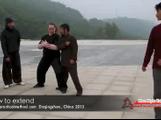The richness of Chen Style Taijiquan Practical Method struck me in 2013 when I had my first encounter with Master Chen and his explanations. There is so much to learn for me. Master Chen told on several occasions, that if you think you know how to do practical method, you can stop to practice, cause you stop learning. There is always something that you don’t know, you can do better, you can improve, that takes time, that someone else knows or knows better … and so on.
At first, I was a bit disappointed. How can I ever learn this martial art? It was the martial art I was always looking for. In all other martial arts lot’s of things seemed to be missing. Only when I was 36 years of age, I found the one martial art that contained it all in my opinion, that was my personal conclusion. Anyway, Chen Style Taijiquan Practical Method, I found out, was the method itself, the solution to my disappointment: practice according to what you learned, it is a practical method. That cheered me up gradually. To be concrete, here is a list of things that I learned from master Chen, his videos and from other practical method practitioners, that I try to practice while I do my form and foundation training:
6-way stretch
elbow in, hand out
wrists straight
elbow down
don’t move the head
pull/push shoulders down
don’t look down
step in a one, two, three sequence
one joint turns out/opens, the next one turns in, closes
tuck the pelvis in; push it back, but let it not go back from the crutch
keep the spine straight; keep the second spine (underarms) also straight
there is always one foot pumping/pushing out
rotate the joints, do not move the bones
knees point upwards
keep the dang
shoulders and kuas can only compress towards each other
don’t flex your muscles (at my learning stage/beginner)
chest caves in; at two points the chest pushes down
the back is straight
shoulderblades cannot come out
grab the floor with you feet
rotate the torso according to vertical lines (shoulder-kua/spine, the principle of the doorhinge)


